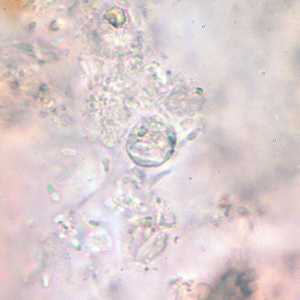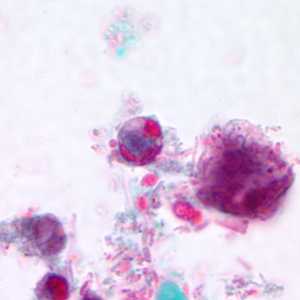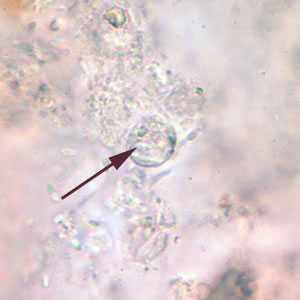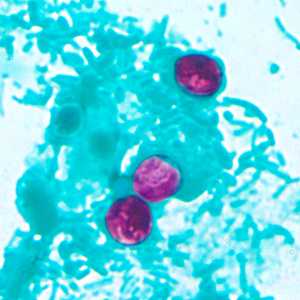
Case #166 - October, 2005
A 13-year-old boy was seen by his pediatrician for watery diarrhea, abdominal cramping, and low-grade fever that had persisted for 3 days. His symptoms began approximately 5 days after returning from a summer camp trip to a petting zoo. The physician ordered an ova and parasites (O & P) exam. The lab personnel followed their typical O & P procedure by performing an FEA concentration from formalin preserved stool and making wet mounts, and using PVA preserved stool to make trichrome stained smears. Figures A and B show objects seen in low numbers on a wet mount (A) and the trichrome stained smear (B). The round objects measured an average of 5 micrometers in diameter. The laboratory reported a presumed diagnosis of parasitic protozoa. What organism do you suspect? Based on what criteria? What, if anything, else needs to be done?

Figure A

Figure B
Case Answer
Based on the images provided in this case, an accurate, definitive diagnosis should not be attempted. The laboratory reported a presumed diagnosis of cryptosporidiosis, because the physician had not ordered the necessary confirmatory testing. Follow-up testing was recommended and a modified acid-fast stained smear was prepared and examined (Figure C, below). Oocysts of Cryptosporidium sp. were observed and, based on this finding, the laboratory could report the result as a case of cryptosporidiosis caused by Cryptosporidium sp. In Figure A, the faint outline in the lower half of the oocyst may be a sporozoite (black arrow). However, this cannot be used as a confirmatory feature due to the lack of appropriate staining of the specimen.

Figure A

Figure B
Safranin and trichrome-stained fecal smears can be used to detect Cryptosporidium spp. Since trichrome is a routine staining technique for stool specimens in most laboratories, lab personnel should be familiar with the appearance of Cryptosporidium stained with trichrome. Although tests for confirmation of Cryptosporidium may not currently be part of a standard O&P exam, laboratory personnel and physicians should be aware that modified acid-fast smears, direct fluorescent antibody (DFA) assays, or enzyme immunoassays are proper procedures that can be used for a definitive identification of Cryptosporidium.
More on: Cryptosporidiosis
Images presented in the monthly case studies are from specimens submitted for diagnosis or archiving. On rare occasions, clinical histories given may be partly fictitious.
DPDx is an education resource designed for health professionals and laboratory scientists. For an overview including prevention and control visit www.cdc.gov/parasites/.
- Page last reviewed: August 24, 2016
- Page last updated: August 24, 2016
- Content source:
- Global Health – Division of Parasitic Diseases and Malaria
- Notice: Linking to a non-federal site does not constitute an endorsement by HHS, CDC or any of its employees of the sponsors or the information and products presented on the site.
- Maintained By:


 ShareCompartir
ShareCompartir